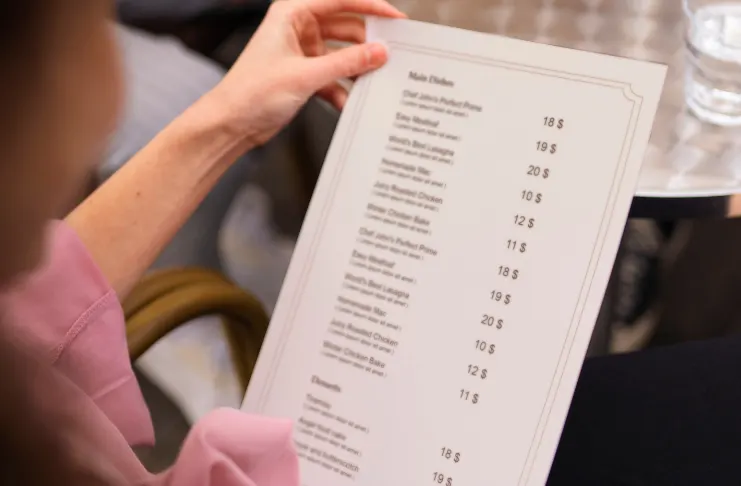In today’s highly competitive restaurant landscape, implementing effective restaurant revenue management strategies is no longer optional—it’s essential. With rising food costs, changing consumer behavior, and labor shortages, operators must adopt smarter, data-driven approaches to stay profitable and sustainable.
Understanding how to increase restaurant revenue goes beyond simply adjusting prices. It involves strategic restaurant revenue optimization techniques that touch every part of the operation—from menu engineering and dynamic pricing to optimizing table turnover and labor efficiency, all aimed to increase restaurant sales . These strategies are designed not just for short-term gains, but for long-term growth and stability.
Thanks to modern POS systems and analytics tools, restaurants now have unprecedented access to actionable insights. Leveraging this sales data helps owners make informed decisions that directly boost restaurant profit, whether through personalized promotions, inventory control, or improved staff scheduling.
By mastering comprehensive restaurant revenue management strategies, restaurant managers can transform underperforming venues into high-performing businesses. The goal is clear: optimize every facet of the customer experience and operation to drive maximum revenue while building a sustainable, resilient brand.
Understanding Restaurant Revenue Management Fundamentals

Effective restaurant revenue management strategies rely on tracking key metrics, smart market positioning, and financial planning to boost total revenue and drive growth.
Core Revenue Metrics Every Restaurant Should Track
To implement effective restaurant revenue management strategies aligned with business objectives, it’s crucial to track key performance metrics that directly influence profitability and long-term growth. Key metrics for restaurant revenue optimization are:
- Average check size is a core indicator of financial performance, reflecting both strategic menu pricing and upselling effectiveness—two vital restaurant revenue optimization techniques.
- Customer lifetime value (CLV) reveals the long-term potential of your guest base. Increasing CLV through loyalty programs and relationship-building efforts can significantly boost restaurant profit.
- Table turnover rate measures how efficiently your team serves guests during peak hours. Optimizing turnover without compromising service quality helps increase restaurant revenue per shift.
- Food cost percentage must be monitored consistently. Maintaining ideal ratios ensures operational efficiency while delivering high-quality dining experiences that support restaurant revenue management goals.
By analyzing these essential metrics, restaurant owners can make smarter decisions that drive revenue, reduce waste, and strengthen long-term profitability.
Market Positioning and Competitive Analysis
To implement effective restaurant revenue management strategies, it’s crucial to understand your market position and local competition. Key restaurant revenue optimization techniques include:
- Define your unique value proposition to guide pricing, menu design, and marketing.
- Use competitive analysis to spot revenue opportunities and attract underserved audiences.
- Align menu and service quality with customer expectations at your price point.
- Tailor optimization strategies—like upselling or pricing—based on your restaurant’s market tier.
Strategic positioning within your local landscape ensures your revenue strategies are targeted, efficient, and built for long-term profit growth.
Financial Planning and Budgeting for Revenue Growth
To implement effective restaurant revenue management strategies, it’s crucial to build a solid financial plan that supports both seasonal demands and long-term goals. Key restaurant revenue optimization techniques include:
- Use historical data and market trends to create realistic revenue projections.
- Prioritize budget allocation toward high-ROI initiatives like tech upgrades or marketing.
- Maintain healthy cash flow to fund revenue strategies without straining operations.
- Integrate growth projections into long-term financial planning for sustained success.
Smart financial planning enables restaurants to boost profit, stay agile, and drive consistent revenue growth.
Menu Engineering and Pricing Strategies

Effective cost control and margin optimization are critical restaurant revenue management strategies that directly boost profit and ensure long-term sustainability.
Strategic Menu Item Placement and Design
To enhance restaurant revenue management strategies, optimizing your menu layout is essential for influencing customer choices and increasing sales. Proven ways to boost restaurant profit through menu design are:
- Position high-margin items in the “golden triangle” — the center, top right, and top left areas of the menu — to capture immediate attention.
- Use detailed, appealing descriptions that highlight quality ingredients to justify premium pricing and elevate perceived value.
- Employ subtle visual cues like boxes or borders to draw focus to key dishes without overwhelming the design.
- Design the menu to guide ordering behavior while maintaining an elegant, inviting presentation.
Smart menu layout techniques not only increase the order frequency of profitable items but also enhance overall customer satisfaction and revenue growth.
Dynamic Pricing and Seasonal Adjustments
To boost restaurant profit and implement effective revenue management strategies, leveraging flexible pricing and promotions is key. Successful restaurant revenue optimization techniques include:
- Adjusting prices dynamically based on demand factors like time of day, day of the week, and seasonality.
- Incorporating seasonal menu changes to control food costs and offer fresh, premium experiences.
- Using happy hour and promotional pricing to increase traffic during slow periods without harming overall revenue.
- Launching limited-time offers to create urgency, drive sales, and test new menu items.
These adaptable pricing strategies help restaurants maximize revenue by aligning with customer behavior and market conditions.
Cost Control and Margin Optimization
To strengthen restaurant revenue management strategies, controlling costs effectively is essential for boosting profit. Practical restaurant revenue optimization methods include:
- Conducting detailed cost analysis for every menu item to maintain profitability and competitiveness.
- Using portion control and standardized recipes to ensure consistent food costs and customer satisfaction.
- Building strong supplier relationships to secure better prices, quality, and payment terms.
- Implementing waste reduction programs to cut food costs and improve overall margins.
By mastering cost control, restaurants can enhance profitability while supporting sustainable growth.
Customer Experience Optimization

Enhancing service standards, ambiance, and technology integration are vital restaurant revenue management strategies that effectively boost restaurant profit and drive sustainable revenue growth.
Service Standards and Staff Training
To boost restaurant profit and optimize revenue management strategies, maintaining consistent, high-quality service is essential. Effective restaurant revenue optimization approaches include:
- Establishing clear service standards to deliver exceptional customer experiences every time.
- Providing comprehensive staff training on technical skills and upselling techniques.
- Offering ongoing development to keep the service aligned with evolving customer expectations.
- Using performance monitoring to identify training needs and reward outstanding service.
Investing in staff excellence drives higher customer satisfaction, repeat visits, and increased revenue per employee.
Ambiance and Atmosphere Enhancement
To effectively increase restaurant revenue and optimize profit, paying attention to the physical environment is a crucial strategy. Proven restaurant revenue optimization techniques include:
- Creating an appealing atmosphere that justifies premium pricing and encourages longer stays.
- Designing lighting to enhance comfort and showcase food, boosting customer satisfaction.
- Selecting background music that aligns with your brand and influences dining pace and spending.
- Maintaining high cleanliness and upkeep standards to reinforce perceived value and reduce complaints.
A thoughtfully crafted dining environment not only elevates the guest experience but also drives higher revenue and repeat business.
INDUSTRY INSIGHT
| A report highlighted that 34 % of U.S. Gen Zs want personalized surprises like free desserts for birthdays. Prioritize atmosphere and ambiance, and work on personalized experiences for your clients when choosing a restaurant model. This demographic is willing to pay a premium for dining experiences that resonate with their personal style and preferences. |
Technology Integration for Enhanced Service
To boost restaurant profit and optimize revenue management strategies, leveraging modern technology is essential. Effective restaurant revenue optimization methods include:
- Using integrated POS and kitchen management systems to reduce errors and speed up service.
- Offering mobile ordering and payment options to enhance convenience and increase table turnover.
- Implementing CRM systems to personalize service, fostering customer loyalty, and repeat visits.
- Utilizing online reservations and waitlist tools to maximize seating efficiency and minimize wait times.
Adopting these technologies improves operational efficiency and elevates the guest experience, driving sustained revenue growth.
Digital Marketing and Online Presence

Implementing targeted digital marketing strategies like social media, online ordering, and email campaigns is crucial for restaurant revenue management strategies to boost restaurant profit and drive sustained revenue growth.
Social Media Marketing Strategies
To effectively boost restaurant profit and optimize revenue management, a strong social media presence is vital. Successful restaurant revenue optimization strategies include:
- Creating consistent, engaging content that highlights your menu, atmosphere, and customer experiences.
- Running targeted Instagram and Facebook ads to reach specific audiences with measurable ROI.
- Encouraging user-generated content to build authenticity and expand your reach organically.
- Hosting social media contests and promotions that drive immediate traffic and customer engagement.
By harnessing the power of social media, restaurants can attract new guests, deepen loyalty, and increase revenue efficiently.
Online Ordering and Delivery Systems
To increase restaurant revenue and optimize profit, implementing efficient online ordering and delivery systems is essential. Digital sales now account for 25% of a restaurant’s revenue, with early adopters seeing up to 50%. Key restaurant revenue optimization tactics include:
- Offering user-friendly online ordering to boost average order values and meet customer convenience demands.
- Expanding reach through delivery services, balancing volume gains against delivery fees.
- Creating delivery-specific menus to maintain food quality and encourage repeat orders.
- Managing third-party delivery platforms carefully to control commission costs and protect profitability.
These strategies help restaurants tap into new revenue streams while maintaining sustainable growth.
Email Marketing and Customer Retention
To boost restaurant profit and optimize revenue management, leveraging targeted email marketing is a highly effective strategy. Proven restaurant revenue optimization techniques include:
- Sending regular newsletters with menu updates, special offers, and restaurant news to keep customers engaged.
- Integrating loyalty programs with email campaigns to reward repeat visits and encourage higher spending.
- Using personalized birthday and anniversary emails to drive special occasion dining with increased transaction values.
- Implementing automated email sequences to nurture new customers and promote return visits efficiently.
Effective email marketing helps restaurants build lasting customer relationships and generate steady revenue growth.
Operational Efficiency and Cost Management

Effective operational management—including inventory control, labor optimization, and energy efficiency—is vital for successful restaurant revenue management strategies that boost restaurant profit and drive sustainable growth.
Inventory Management and Waste Reduction
Effective inventory control is crucial to enhancing restaurant revenue management and boosting profitability. Essential restaurant revenue optimization practices include:
- Implementing systematic inventory management to avoid overstocking and improve cash flow.
- Using first-in-first-out rotation to minimize spoilage and maintain food quality.
- Building strong vendor relationships for better pricing, reliable deliveries, and consistent products.
- Tracking waste closely to identify reduction opportunities and increase profit margins.
Strong inventory management supports cost control and sustainable revenue growth for restaurants.
Labor Optimization and Scheduling
To optimize restaurant revenue management and boost profitability, strategic labor management and inventory tracking are essential. Effective restaurant revenue optimization strategies include:
- Scheduling staff based on demand patterns to control labor costs and maintain service quality.
- Implementing cross-training to increase workforce flexibility and reduce labor needs during slow times.
- Using performance-based incentives to motivate staff toward higher sales and better customer experiences.
- Conducting thorough labor cost analysis, including wages, benefits, training, and turnover expenses.
Smart labor management enhances operational efficiency and supports sustainable revenue growth.
Energy Efficiency and Utility Management
To boost restaurant profit and optimize revenue management, investing in energy efficiency is a smart strategy. Key restaurant revenue optimization techniques include:
- Upgrading to energy-efficient equipment to reduce operational costs and increase profitability.
- Monitoring utility usage regularly to identify and act on conservation opportunities.
- Implementing equipment maintenance programs to ensure peak efficiency and prevent costly repairs.
- Utilizing smart building technologies to automate energy management and maintain guest comfort.
Energy-efficient practices lower expenses and support sustainable, long-term revenue growth for restaurants.
Revenue Diversification Strategies

Expanding revenue streams through catering, retail, and event hosting while effectively managing food waste is a powerful approach within restaurant revenue management strategies to boost restaurant profit and achieve sustainable growth.
Catering and Off-Site Services
To increase restaurant revenue and optimize profit, tapping into catering opportunities is a highly effective strategy. Proven restaurant revenue optimization methods include:
- Building corporate catering relationships to secure recurring, reliable income streams.
- Offering special event catering with premium pricing for weddings, parties, and custom services.
- Designing catering menus focused on food quality, transportability, and efficient preparation.
- Planning delivery logistics carefully to ensure a timely, attractive presentation and customer satisfaction.
Expanding into catering helps restaurants diversify revenue and build loyal customer bases.
Retail and Merchandise Opportunities
To boost restaurant profit and diversify revenue streams, leveraging branded products and programs is an effective strategy. Key restaurant revenue optimization techniques include:
- Creating signature sauces and spice blends for retail sales to generate ongoing income and build brand loyalty.
- Offering branded merchandise like apparel and glassware that drives additional revenue and marketing exposure.
- Implementing gift card programs to improve cash flow and encourage repeat visits.
- Publishing cookbooks or sharing recipes to showcase expertise and engage loyal customers.
These initiatives expand revenue opportunities while strengthening customer connections and brand recognition.
Event Hosting and Private Parties
To increase restaurant revenue and optimize profit, hosting special events is a highly effective strategy. Proven restaurant revenue optimization methods include:
- Offering wedding and reception services that command premium pricing and showcase event expertise.
- Hosting corporate events to attract repeat business clients seeking professional services.
- Celebrating birthdays and anniversaries with personalized experiences that drive higher spending and referrals.
- Organizing holiday parties during slow seasons to boost revenue and build community relationships.
Expanding into event hosting helps restaurants generate substantial, diversified income while strengthening customer loyalty.
Technology Integration for Revenue Optimization

Integrating advanced technology solutions like POS systems, CRM, and online reservations is crucial for effective restaurant revenue management strategies that boost profit and streamline operations.
According to a report, 73% of restaurant operators increased their technology investments this year, marking the highest rate of digital adoption in the sector’s history.
Point-of-Sale Systems and Analytics
To boost restaurant profit and optimize revenue management, leveraging advanced POS technology is essential. Effective restaurant revenue optimization techniques include:
- Using detailed sales analytics to understand customer behavior and guide menu and pricing decisions.
- Monitoring real-time reports for quick adjustments in staffing, inventory, and service during operations.
- Integrating POS with loyalty programs to personalize marketing and increase customer lifetime value.
- Applying sales forecasting to optimize staffing and inventory based on expected demand.
Harnessing these POS capabilities enables data-driven decisions that drive consistent revenue growth and operational efficiency.
Customer Relationship Management Systems
Effective customer relationship management (CRM) is key to enhancing restaurant revenue management and boosting profit. Proven restaurant revenue optimization strategies include:
- Using CRM systems to track guest preferences, visit frequency, and spending habits for deeper insights.
- Automating targeted marketing campaigns that encourage repeat visits and higher spending.
- Leveraging birthday and anniversary tracking to drive special occasion dining with personalized offers.
- Collecting and analyzing customer feedback to improve service quality and increase satisfaction.
Strong CRM practices foster loyal customers and unlock new revenue opportunities through personalized engagement.
Online Reservation and Table Management
To optimize restaurant revenue management and boost profitability, leveraging online reservation technology is essential. Effective restaurant revenue optimization techniques include:
- Using online reservation systems to offer convenient booking and reduce phone traffic.
- Integrating table management software to maximize seating capacity and improve turnover during peak times.
- Employing waitlist management tools to efficiently handle walk-ins and maintain smooth service flow.
- Utilizing customer communication features to send confirmations, promotions, and reduce no-shows.
These tools enhance operational efficiency and customer experience, driving higher revenue and repeat visits.
Seasonal Strategies and Adaptation

Seasonal promotions and local events play a key role in restaurant revenue management, driving sales and building customer loyalty through targeted marketing and community involvement.
Holiday and Special Event Marketing
Seasonal and holiday-themed promotions are powerful restaurant revenue optimization strategies that drive sales and customer loyalty. Key tactics include:
- Crafting holiday-themed menus that justify premium pricing and create memorable dining experiences.
- Running targeted campaigns for occasions like Valentine’s Day and Mother’s Day to boost reservations and average check sizes.
- Hosting New Year’s Eve and other major celebrations to generate significant revenue and showcase event expertise.
- Marketing milestone events, such as graduations, to attract group dining and foster long-term customer relationships.
Leveraging these special occasions helps restaurants increase revenue while building a loyal customer base through unique, timely experiences.
Weather-Responsive Menu Planning
Seasonal adjustments to the restaurant menu are essential restaurant revenue optimization techniques that boost sales and manage food costs effectively. Key strategies include:
- Featuring fresh, local ingredients to attract loyal customers and food enthusiasts.
- Offering comforting cold-weather dishes like soups and stews that encourage higher-margin sales in winter.
- Creating lighter summer menus with salads, cold soups, and grilled items to appeal to warm-weather diners.
- Adapting beverage programs to seasonal preferences, boosting profits with hot drinks in winter, and refreshing beverages in summer.
Embracing seasonality helps restaurants increase revenue while delivering appealing, timely dining experiences.
Local Event Coordination
Engaging with the local community is a smart restaurant revenue management strategy that boosts visibility and drives sales. Effective approaches include:
- Participating in community festivals to connect with new customers and build lasting loyalty.
- Running sports season promotions linked to local teams, encouraging repeat visits during games.
- Partnering with concert and theater venues to attract event-goers and increase weekend revenue.
- Joining farmers markets to highlight fresh, local ingredients and attract health-conscious diners.
These community-focused efforts help restaurants expand their customer base and strengthen revenue streams through meaningful local engagement.
Performance Monitoring and Analytics

Tracking key performance indicators, leveraging data analysis, and embracing continuous improvement are essential pillars of effective restaurant revenue optimization strategies that drive sustained profit growth.
Key Performance Indicators for Revenue Optimization
Tracking key metrics is vital for effective restaurant revenue optimization strategies. Important metrics to focus on include:
- Average transaction value, which measures the success of upselling, pricing, and customer perception.
- Customer acquisition cost, helping optimize marketing spend and campaign effectiveness.
- Customer retention rates, indicating loyalty and long-term revenue stability.
- Table turnover rates during peak times, balancing efficiency with quality to maximize revenue capacity.
Monitoring these metrics enables restaurants to make data-driven decisions that boost revenue and sustain profitable growth.
Data Collection and Analysis Systems
Effective restaurant revenue management strategies begin with robust data collection and analysis systems that integrate sales, customer feedback, and operational metrics to provide actionable insights.
- Integrated POS and feedback systems reveal correlations and trends critical for informed decision-making.
- Regular weekly and monthly reporting schedules track performance and highlight areas for revenue improvement.
- Comparative analysis of different time periods helps identify seasonal trends, enabling precise restaurant revenue optimization techniques.
- Monitoring staff performance uncovers training needs and recognizes top performers, boosting overall service quality and profitability.
Leveraging comprehensive data collection and analysis is a foundational step in how to increase restaurant revenue by enabling smarter, evidence-based revenue optimization.
Continuous Improvement Processes
Continuous improvement is a key component of restaurant revenue management strategies, ensuring operations evolve based on real performance data and customer insights.
- Regular menu analysis identifies underperforming items for adjustment or removal, directly enhancing profitability.
- Service quality monitoring through customer feedback and mystery shopping drives ongoing enhancements in guest experience.
- Periodic cost reviews reveal expense reduction opportunities without compromising service quality.
- Encouraging staff feedback fosters operational innovation and uncovers hidden revenue growth opportunities.
Adopting continuous improvement processes helps restaurants sustain growth by refining key revenue drivers, an essential part of effective restaurant revenue optimization techniques.
Long-term Growth and Sustainability

Effective brand development, strategic expansion, and timely adaptation to industry trends are essential restaurant revenue management strategies that drive growth, customer loyalty, and long-term profitability.
Brand Development and Market Positioning
Strong brand development and market positioning are vital restaurant revenue management strategies that enhance customer loyalty and justify premium pricing.
- Consistent brand messaging across all touchpoints builds trust and strengthens customer relationships.
- Unique value propositions differentiate the restaurant in competitive markets and support revenue growth.
- Active community involvement boosts brand recognition and fosters long-term customer loyalty.
- Maintaining quality consistency encourages repeat visits and positive word-of-mouth referrals.
A well-defined brand and clear market positioning are powerful tools in how to increase restaurant revenue through lasting customer engagement and pricing power.
Expansion and Franchise Opportunities
Strategic expansion and franchise opportunities can multiply revenue streams and scale restaurant profitability when executed with careful planning. Nearly 80% of franchised businesses are profitable within their first year.
- Thorough evaluation of new markets and sufficient capital are prerequisites for successful growth.
- Franchise development offers growth with lower capital investment and operational risk, generating steady royalty income.
- Market research should focus on demographics, competition, and economic conditions to select promising locations.
- Standardized operational systems and training ensure consistent quality and brand experience across all sites.
Expanding thoughtfully and leveraging franchising as part of restaurant revenue management strategies can significantly boost long-term profitability and business resilience.
Adaptation to Industry Trends
Staying ahead with industry trend adaptation is a critical restaurant revenue optimization technique that keeps businesses competitive and relevant.
- Continuous monitoring of market trends helps anticipate shifts in customer preferences and competitor actions.
- Technology adoption aligned with customer needs improves efficiency and enhances the dining experience.
- Balancing innovation with customer favorites in menu trends attracts new guests while retaining loyal customers.
- Evolving service models ensure responsiveness to changing market conditions and consumer expectations.
Restaurants that proactively adapt to trends and technology position themselves for sustainable growth, optimizing revenue while maintaining customer satisfaction.
Conclusion
In conclusion, mastering restaurant revenue management strategies is crucial for any operator aiming to thrive in today’s competitive market. By understanding how to increase restaurant revenue through data-driven insights and strategic initiatives, restaurants can unlock new growth opportunities and improve profitability sustainably. Implementing proven restaurant revenue optimization techniques—from menu engineering and dynamic pricing to efficient labor scheduling and inventory control—enables operators to maximize every revenue stream while maintaining exceptional customer experiences.
As highlighted, leveraging modern technology such as advanced POS systems and analytics tools provides the foundation for making smarter decisions that directly boost restaurant profit. These tools empower restaurants to tailor offerings, optimize operations, and adapt quickly to changing market demands.
Ultimately, successful restaurant revenue management strategies require a holistic approach that aligns operational efficiency with customer satisfaction and brand development. Restaurants that invest in these areas position themselves not only to increase immediate revenue but also to build long-term resilience and market relevance.
By embracing these comprehensive strategies, operators can transform their businesses into profitable, sustainable ventures that stand out in the evolving restaurant industry landscape.
Frequently Asked Questions
1. What are the 3 strategic pillars of revenue management?
Pricing strategy, inventory control, and demand forecasting form the three strategic pillars of revenue management.
2. What are the 5 pillars of revenue management?
Pricing, inventory control, demand forecasting, distribution management, and market segmentation make up the five pillars of revenue management.
3. What are the 7 core principles of revenue management?
Market segmentation, differential pricing, capacity management, demand forecasting, dynamic pricing, channel management, and data-driven decision-making are the seven core principles.
4. What is revenue management in restaurants?
Revenue management in restaurants involves strategically optimizing pricing, menu offerings, and operations to maximize profitability.
5. How to make a restaurant more profitable?
Profitability increases by optimizing menu design, controlling costs, enhancing customer experience, and efficient staff scheduling.
6. How to increase sales of restaurants?
Targeted marketing, upselling, loyalty programs, and improving service quality drive higher restaurant sales.
7. How do I attract customers to my restaurant?
Strong branding, social media engagement, promotions, and memorable dining experiences attract more customers.
8. How do restaurants make the most money?
Maximizing profits involves optimizing menu pricing, minimizing waste, increasing table turnover, and diversifying revenue streams.
9. How to increase profitability in a restaurant?
Managing food and labor costs, optimizing pricing strategies, and enhancing operational efficiency lead to increased profitability.
10. How to increase F&B revenue?
Upselling, bundling menu items, seasonal promotions, and expanding beverage offerings boost food and beverage revenue.
11. What is a restaurant revenue model?
A restaurant revenue model outlines how income is generated through food and beverage sales, catering, and additional services.
12. What is revenue optimization?
Revenue optimization means using data and strategies to maximize income from available resources and market opportunities.
13. How much profit do you make owning a restaurant?
Typical restaurant profit margins range from 3% to 6%, depending on concept and management.
14. How much profit does a high-end restaurant make?
High-end restaurants often achieve profit margins between 10% and 15% due to premium pricing and strong brand value.
15. Is $10,000 enough to open a restaurant?
Most full-service restaurants require significantly more capital than $10,000 to cover startup costs.





